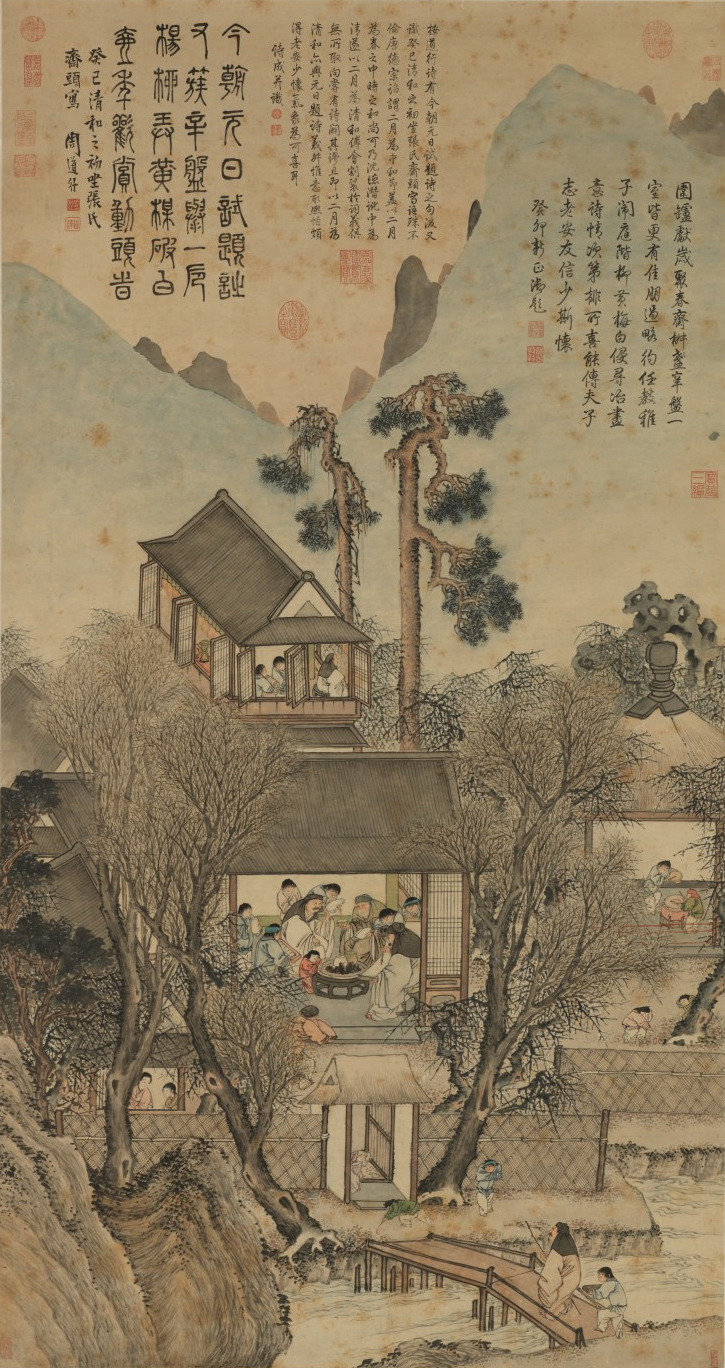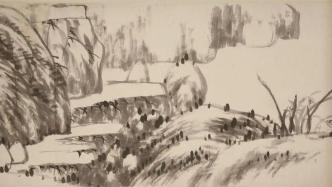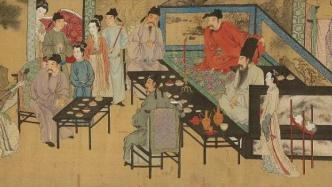
The Paper learned that "The World - All Kinds of People in Ming and Qing Paintings" was recently exhibited at the Tianjin Museum. The exhibition was jointly organized by the Tianjin Museum and the Chongqing China Three Gorges Museum, and brought together many fine collections from the two museums, including the highly anticipated "Ten Thousand Hus Facing the Sky" (collected by the Tianjin Museum) and Tang Yin's "Night Banquet of Han Xizai" (collected by the Chongqing China Three Gorges Museum), as well as a number of precious cultural relics from the Tianbo Museum that were exhibited for the first time, such as Huang Bi's "A Picture Album of Farming and Weaving", Chang Yin's "A Picture Scroll of Pleasure", Zhu Ruiqing's "A Picture Album of Figures", Guo Shangting's "A Picture Scroll of Zhangwu Rescuing a Drowned Person", etc. The exhibition exhibited a total of 76 pieces/sets of works, presenting the audience with the colorful material life and spiritual world of the ancients through the reflection of the social, political, economic and cultural aspects of the Ming and Qing Dynasties in the paintings.
During the Ming and Qing Dynasties, social and economic development led to the prosperity of civic culture and injected new vitality into Chinese painting. Not only did artistic theory and expression forms rise to new heights, but the content of paintings was further enriched and developed on the basis of inheriting traditional themes.
Tianjin Museum has a rich collection of paintings from the Ming and Qing dynasties, covering a wide range of subjects. Chongqing China Three Gorges Museum has treasures from famous artists with unique local characteristics. The exhibition "The World - All Kinds of Life in Ming and Qing Paintings" is based on an in-depth exploration of the collections of the two museums. Combined with the research results of related collections in recent years, it innovatively starts from the content of the paintings for the first time, conveying the cultural charm by telling good stories about cultural relics.
The exhibition displays a total of 76 pieces/sets of precious cultural relics, which are divided into four units: Festivals and Customs, Prosperity of All Industries, Changing Times and Entertainment. It interprets the four aspects of festivals and customs, labor production, life and leisure and entertainment reflected in the paintings of the Ming and Qing Dynasties. Through the reflection of the social, political, economic and cultural aspects of the Ming and Qing Dynasties in the paintings, it presents the audience with the splendid material life and spiritual world of the ancients.
Festival sequence and wind
Work at sunrise and rest at sunset. Plough in spring, weed in summer, harvest in autumn and store in winter. The four seasons affect the production and life of the ancients. As time goes by, activities with specific connotations have evolved into customary festivals, accompanied by the continuous integration of religious beliefs, historical allusions, seasonal diet, health care, entertainment and recreation. From ancient times to the present, there has been evolution and transfer, and the inheritance has continued, eventually forming a diverse, integrated and unique Chinese festival custom.
From New Year's Day to New Year's Eve, Ming and Qing Dynasty paintings have vivid and detailed depictions of the rich and colorful festival culture including ancestor worship, banquets, purification rituals, spring outings, dragon boat races, begging for skills, climbing mountains, and staying up all night, which have become the most intuitive material for us to understand the ancient people's festival activities today.

Ming Dynasty Zhou Daoxing Suichao Tu Scroll Tianjin Museum Collection

Lanting Xiuxi Tujue by Gong Yourong of the Qing Dynasty (partial) Collection of Chongqing China Three Gorges Museum

Sketch page of Baodongdou in the Qing Dynasty, from the collection of Tianjin Museum
All industries prosper
Farmers cultivate land and grow crops, craftsmen use their skills to make tools, and merchants make money and sell goods. Farmers, craftsmen, and merchants constitute the main body of material production activities in ancient China. Under the rule of agriculture-based and encouraging agriculture and sericulture, farmers worked tirelessly to grow crops and make the self-sufficient small peasant economy flourish. The abundance of grains led to the prosperity of all industries. The development of agriculture promoted the prosperity of handicrafts and commodity economy. Craftsmen used tools to carry the truth, and merchants spread all over the world, material wealth and civilization grew.
Through the inheritance and development of traditional themes such as farming, weaving, fishermen, peddlers, and travelers, Ming and Qing Dynasty paintings reproduced the production activities of the time, such as farming, fishing, woodcutting, mulberry weaving, and merchants trading, and showed the Chinese nation's unremitting struggle for the social ideal of ample food and clothing and a prosperous and peaceful life.

Qing Dynasty Zhu Lunhan's finger painting of herding cattle, collected by Chongqing China Three Gorges Museum

Selections from Huang Bi's Album of Farming and Weaving in the Qing Dynasty, Collection of Tianjin Museum

Traveling in Shushan by Li Yin, Qing Dynasty, Tianjin Museum Collection
Times change
Times change, dynasties come and go, and on this historical stage where the fate of individuals, families and countries are intertwined, dramas of the impermanence of life and the various aspects of life are constantly played out. When the country is prosperous, people's livelihood is peaceful; when wars are frequent, people live in poverty. In the paintings of the Ming and Qing Dynasties, there are not only bustling markets in the prosperous times, but also idyllic places far away from the turmoil, and peaceful rural life; there are also displacements under frequent wars and disasters. "Worry about the world before you worry about yourself, and be happy after the world is happy." The painters use their brushes and ink to focus on social reality, express humanistic care, and vividly show the life of all classes under the background of the times.

Unmarked scroll of "Ten Thousand Hus Facing the Sky" from the Qing Dynasty (partial) Collection of Tianjin Museum

Unmarked scroll of "Ten Thousand Hus Facing the Sky" from the Qing Dynasty (partial) Collection of Tianjin Museum

Qing Dynasty Zhu Zhaoyi, A Selection of Pictures of Blind People Enjoying Themselves, Collection of Chongqing China Three Gorges Museum

Picture of Qing Zhongji's children's play, from the collection of Chongqing China Three Gorges Museum

Qing Changyin Xingle Tujuan Tianjin Museum Collection

Ming Dynasty Tang Yin and Han Xizai Night Banquet Scroll (partial) Chongqing China Three Gorges Museum

Ming Dynasty Tang Yin and Han Xizai Night Banquet Scroll (partial) Chongqing China Three Gorges Museum
Entertainment
People work all year round and are tired and exhausted. Leisure and entertainment have become an important way to adjust their lives. They can relax and unwind with work in a proper way, relieve people's fatigue, soothe people's spirits, and make people feel lively and happy physically and mentally. This unit interprets the elegant affairs of literati and the interests of ladies in their boudoirs through paintings, showing their entertainment and leisure methods of self-cultivation and cultivating their sentiments in the joy of sharing and enjoying alone, material satisfaction and spiritual pleasure, and showing their pursuit and realization of spiritual freedom and personal values in the confinement of reality.

Qingxi Horizontal Flute Scroll Yun Shouping and Niu Zishuo of the Qing Dynasty Qingxi Horizontal Flute Scroll Tianjin Museum Collection

Qing Shitao Song'an Reading Picture Scroll Chongqing China Three Gorges Museum

Huang Shen's Orchid Painting Scroll from the Qing Dynasty, Collection of Chongqing China Three Gorges Museum

Selection of the Album of Ladies by Shen Zongqian of the Qing Dynasty, Collection of Tianjin Museum

Exhibition poster
Exhibition name: The myriad phenomena of the world: the various forms of life in paintings of the Ming and Qing dynasties
Exhibition time: January 25th - May 5th
Exhibition location: Tianjin Museum
(The pictures and text of this article are compiled from the official Weibo of Tianjin Museum)


